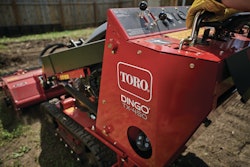Brian Etchison had one problem with the excavtor buckets being run at RA Janes Gravel Co. in Merkel,Texas. None of them could stand up to the abrasive conditions at Janes” sand and gravel mine. “Every bucket we”ve had we destroyed,” said Etchison, vice president at RE Janes. “Just because of the nature of what we”re doing.” So when Volvo approached Etchison with its new bucket, he was ready to put it to the test.
“Our materials is really abrasive. It”s fairly hard breakout,” Etchison said. “I can take you to several buckets that we”ve had on different excavators. We”ll actually break them. We sometimes will break a lip completely off the bottom of a bucket. We”ve split them up the middle.”
Janes Gravel uses a Volvo EC460B excavator in what is essentially a strip mining operation about 30 miles west od Abiline. The material is hard, densely packed sand and gravel, mixed with conglomerate and clay. The excavator loads 80-ton belly-dump haulers, which take the material for nearby proccessing and eventual use in ready mix concrete. “It”s definitely not an easy environment for a machine to dig,” Etchison said.
So after losing two buckets to the extreme conditions, Etchison was all ears when approached about a new 3.6-cubic-yard bucket by Walter Reeves, attachments manager for Volvo Construction Equipment. “When he was telling me about this bucket before it arrived,” Etchison said, “he was drawing it on a napkin for me and showing me. He said, “You”re going to have better success with this shape.” And it is a better shape.”
A new shape, a new approach
With a low profile and curved shape, Volvo”s new buckets have optimized cutting edges, heavy fabrication and self-sharpening teeth. The design of the bucket floor makes it easy for material to flow into and fill the bucket with no air gaps. Anti-abrasive side cutters and lip plating give the buckets exceptional wearability.
“These are made to load easy and dump easy,” Reeves said.”This penetrates nice and easy. The material just flows right out of the bucket. It improves your cycle times.” With the new Volvo bucket installed on the EC460B excavator, the company adopted a new approach to digging. Instead of using the excavator”s breakout power to extract the material, the operator uses the teeth to penetrate, then pulls the bucket nearly flat toward the excavator. Material marches into the bucket without the boiling that can cause air pockets and incomplete fills. As the bucket comes up out of the hole, it cradles the material without requiring extreme curl of the bucket. Less curl means less machine wear and quicker dumps.
“The shape is the main thing that protects the linkage,” Etchison said, “because the material enters the bucket more easily than a deeper, taller bucket. In the past I thought a more narrow bucket that was deeper and taller would have less surface area to cut the material and would not have a negative impact on the linkage. But the wider more shallow, more curved shape of this bucket, I think it”s a better design for this.” With a deeper, taller bucket, material is more likely to stick, causing the operator to bang the bucket in its full open position in order to dislodge the material.
Working in extreme conditions
RE Janes Gravel Co. is one of the largest suppliers of sand and gravel in Texas. The U.S. Geological Survey lists the company in its national directory of the principal suppliers of sand and gravel. While the company operates three mining operations in Texas, it is the Merkel facility that has the most extreme digging conditions.
“It”s very densely packed sand and gravel. Its a fairly dirty deposit, so it”s got a lot of clay in it,” Etchison said. “There”s some conglomerate. As far as abrasiveness, in the pits we have throughout the company, we go through a lot of scraper teeth and things like that just getting down to the deposit. When you get down to the material, you can process, it”s very abrasive. You go through teeth very quickly.”
The Volvo EC460B operates at least 10 hours per day loading the haulers and also maintaining the pit. “The excavator”s a useful tool to be used in other places for repair days. It might dig a ditch or two, but it”s primary function is in hard digging. It is the central machine to the operation,so Jane Gravel cannot afford downtime from damaged buckets.
“You”ll see on the Volvo bucket where it kind of wraps around, it has a wear plate that”s actually a part of the bucket that”s kind of a shoulder down the sides,” Etchison said. Where a lot of other buckets are put together right there at theat corner, and all that is stick weld. Once you get to that weld, it”s going to crack apart. Volvo”s just seems to be a better design in that position.
“I think it”s a good bucket. Overall, it;s performing well. It”s the right shape bucket. They are going in the right direction.”
“We have something here”
The way Rick Leaverton sees it, RA Janes Gravel Co. is really onto something with the new Volvo excavator bucket. “We have something here with this Volvo bucket,” said Leaverton, sales manager with Associated Supply Co (ASCO), the local Volvo dealer in West Texas. It”s exciting to see it work so well for a key customer.” Volvo”s new line of excavator buckets includes general purpose models for soft to medium materials, heacy duty versions for gravel or clay, rock buckets for sharp, fractured materials, ditch-cleaning buckets and extra performance(XP) buckets with a unique curved floor and self-filling design.
Walter Reeves, attachments manager for Volvo Construction Equipment, said one of the keys to the buckets is how the teeth penetrate the material without over-stressing the bucket lip. “If you eat a sandwich, you eat it with your teeth, not with your lips.”











